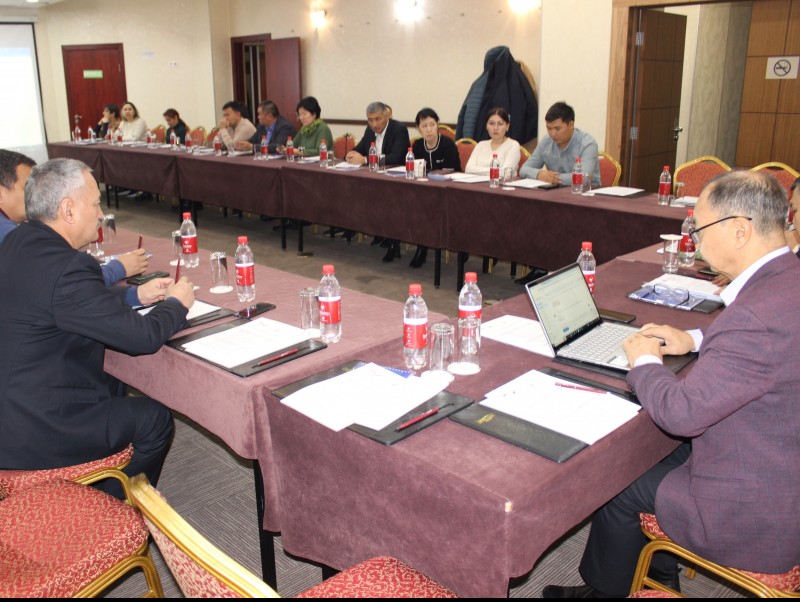
Pasture monitoring is an essential tool through which specialists assess the state of pastures, determine the impact of livestock grazing on resources, and incorporate them into pasture management plans. Just a year ago, different methodologies were used locally to assess pasture conditions. However, experts have now developed a unified system aimed at pasture committees and resource users nationwide. The initiative to unify methodologies and bring them under a common framework was put forth by the Department of Pastures and Livestock Breeding at the Ministry of Agriculture of the Kyrgyz Republic (DPPLB MoA KR). Consultative and technical support to the government agency was provided by the СAMР Alatoo Foundation with financial support from the regional program "Integrated Land Management with Climate Change Consideration in Central Asia" of the Deutsche Gesellschaft für Internationale Zusammenarbeit (GIZ) GmbH.
Throughout 2023, the interdepartmental working group (IWG) was responsible for developing a unified methodology for monitoring and assessing pasture conditions. The results of their work were presented at a meeting of the Coordination and Consultation Council (CCC) on sustainable pasture management and effective use. The event involved representatives from government agencies, international and non-governmental organizations, and experts specializing in natural resources.
Maksatbek Mamytbekov, Deputy Director of DPPLB MoA KR and head of the IWG, noted that the methodology would be legislatively established to make the unified pasture monitoring procedure mandatory for resource users at the local level.
Natalya Barakanova, a pasture management specialist from ARIS and a member of the IWG, reported that, out of four existing approaches, the measurement rail method was selected as the foundation. This method allows collecting data on coverage and botanical composition, determining plant height, edibility, and inedibility, and assessing pasture productivity. "During the assessment, users can also apply visual methods and photo monitoring. If the same pasture area is photographed from the same angle for several years, it provides visual confirmation of changes," said Natalya Barakanova. Among the tools accompanying pasture land monitoring, IWG members emphasized the importance of digital technologies. According to experts, using the "Pasture Monitoring" mobile application and an electronic catalog of pasture plants will significantly simplify data collection, documentation, and subsequent analysis. All collected information will be compiled into a single electronic database for data entry and monitoring, and work on its development is still ongoing. Developers explained that a significant portion of the information (contained in the methodology) has already been uploaded into the system, and monitoring specialists will only need to specify some details (such as the location and name of the pasture area, etc.).
The methodology is outlined in the "Guide to Monitoring and Assessment of Pasture Lands at the Local Level," based on which a step-by-step instruction for applying the algorithm in practice was developed. Representatives of local self-governance bodies and pasture committees participated in testing the methodology in selected rural municipalities across all regions. Together with IWG members, they collected field data, which was then analyzed and presented as "Pasture Capacity Maps" and "Pasture Condition Maps." The accuracy and reliability of the maps were coordinated with users from pilot rural municipalities. Additionally, during the methodology development, IWG members underwent intensive training in data analysis using geographic information systems, including the processing of satellite imagery. The result of this training cycle was the "Pasture Condition Map" showing the degradation levels of pastures in the pilot rural municipalities. Responding to questions during the meeting about positive trends in improving pastures in the pilot area, experts emphasized the need for multi-year pasture monitoring.
Regarding the IWG's future work, its members will refine the unified methodology considering proposals made by CCC members. The next step will be the process of legislating the methodology.
Итоги пастбищного сезона 2018 года были подведены на очередном заседании районной пастбищной комиссии (РПК).
MoreThe development of the unified method, "Monitoring Pastures at the Local Level," is nearing completion.
MoreЧетыре новых моста построены в 2018 году в Кыргызстане при поддержке ОФ “CAMP Алатоо” и Швейцарской ассоциации “Памирские...
More